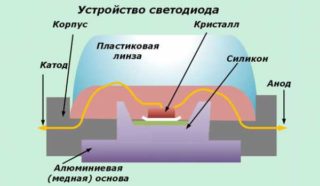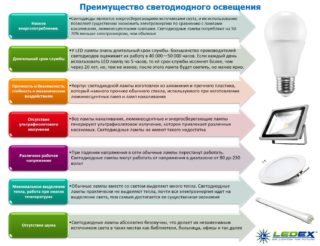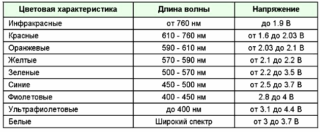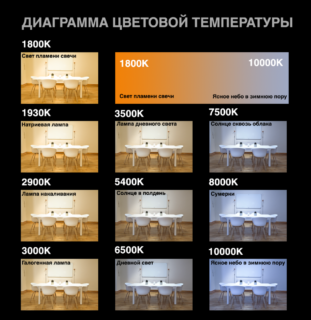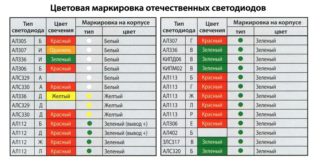Initially, LEDs were used as indicators or in small devices. For example, in garlands or switches as a backlight. Modern devices are able to completely replace the usual lamps in home, outdoor conditions, in industry, offices. To make the best choice, you need to familiarize yourself with the main points before buying.
- Classification of LEDs by their field of application
- Indicator LEDs
- Lighting LEDs
- Advantages and disadvantages
- Main characteristics
- LED current consumption
- Rated voltage
- Light diode resistance
- Light output and luminous angle
- LED lamp power
- Colorful temperature
- LED Chip Size
- Checking an LED with a multimeter
- LED color coding
Classification of LEDs by their field of application
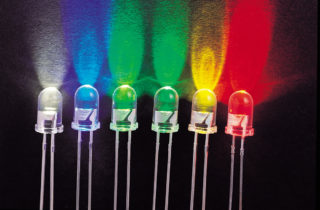
LED lighting elements differ in their area of application. The main types of LEDs: indicator and lighting. The devices are not the same, each has its own distinctive features and technical parameters.
Indicator LEDs
The first LED lamp appeared in the middle of the last century. The device had a dull reddish glow, low energy efficiency. Despite the shortcomings, developments in this direction were continued. After 20 years, variants with a yellow and green tint appeared. By the beginning of the 90s, the luminous flux reached 1 Lumen. By the early 2000s, the value had reached 100 Lumens.
In 1993, Japanese engineers introduced the blue LED. The light of the device has become much brighter than its predecessors. From that moment on, devices with different luminescence began to appear on the market - the combination of blue, green, yellow and red allows you to create any color and shade.
Currently, the development continues. New types of LEDs are emerging. At the same time, low-voltage consumption is maintained while increasing the luminous flux.
Lighting LEDs
Such LEDs are called lighting LEDs due to their main field of application. Used in ribbons, headlights, lamps, and other products. Manufactured in separate housings that allow surface mounting.
The main difference is that they give out only white light of cold or warm shades. Classification:
- SMD - models with a diffuser at 100-130 ° are popular; copper or aluminum lamp base, do not heat up;
- COB - more powerful, super-bright, consist of many small crystals, the scattering angle is significant;
- Filament - have the lowest efficiency (in comparison with SMD), are often used as decorative elements, are made in various sizes and shapes.
Based on the purpose and parameters of the room, the best option is chosen. The characteristics of the lighting devices are indicated on the packaging and in the technical documentation.
Advantages and disadvantages
- saving energy without compromising the luminous flux of the lamp;
- durable materials of the body and internal elements: low probability of mechanical damage;
- long term of use: several times higher than that of Ilyich's bulbs;
- size: diodes are compact and mobile enough;
- high brightness;
- safety: minimum mains voltage - 3-24V.
Among the disadvantages, the high cost and the need for constant voltage are noted. The price of products is gradually decreasing due to high consumer demand.
Main characteristics
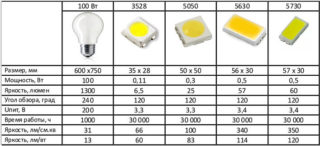
The technical parameters of LEDs differ depending on the model. Common indicators are:
- consumed current;
- nominal voltage (product voltage);
- power of consumed electricity (volt-ampere graph);
- glow temperature;
- luminosity (luminous flux level).
There are other characteristics, but they are rarely referred to. For domestic use, it is enough to take into account only these parameters of the LEDs.
LED current consumption
The indicator allows you to find out the amount of current consumed electrically by the device (LED). For devices with one active crystal, a value of 0.02A is sufficient. If the number is greater, the characteristic increases by a multiple of the number of elements. According to this parameter, a resistor (stabilizer) is selected, which is installed at the input.
The stabilizer allows you to keep the device in working order in case of voltage drops, regardless of the reason. Moreover, fluctuations in the LED current value change the color temperature of light from warm to brighter, colder. If the voltage jump is significant, the diode will burn out instantly without an additional resistor.
To choose the right stabilizer for converting current, you can use a special online calculator.
Rated voltage
LED current and voltage must match. Otherwise, the diodes will either burn out quickly or will not emit light at the declared level.
To find out how many Volts the LED is, you can use a multimeter or determine by the color of the glow. For the first method, you need a multimeter and a resistor - the value will appear on the display after assembly.
Light diode resistance
The resulting resistance depends on the electrical circuit to which the element is connected. The same LED can show a different value. For example, at the input - about 1 kΩ, at the output - several MΩ. However, resistance is not a linear characteristic. The indicator is inversely proportional to the voltage supplied to the mains. The higher the LED supply voltage, the lower the resistance level of the device.
Light output and luminous angle
It is difficult to compare the level of light output of different lamps. For example, a 5 mm LED emits 1-5 lm, and a 70 W incandescent lamp gives 750 lm. The scattering angle is selected based on the area of the room. In the corridor, there is enough diode at 30 °, in the room it is better to use elements of 90-120 ° or several at the same time. The maximum angle of LED luminaires is 120 °. The most illuminated place is the center, towards the periphery the light is scattered.

LED lamp power
The power of a diode depends on several related metrics. For LEDs, the value ranges from 0.5 to 3 W. It is calculated according to Ohm's law: it is necessary to multiply the values of the current and voltage. The current-voltage characteristic (VAC) of the LED is also determined.
The choice of the power supply unit of the device depends on the power level and I - V characteristic of the LED. It is not allowed to use inappropriate elements - the lamps will burn out if the voltage and current are too high.
Colorful temperature
- 2700-3000 - warm, yellowish;
- 3500-4000 - daytime, neutral;
- 5500-7000 - cold, with blue.
The main shades are presented. In practice, there are much more colors. The temperature is selected based on the purpose of the room, the required level of comfort and user preferences. For example, it is recommended to install lamps with warm light in the bedroom, and with a natural shade in rooms without windows.
LED Chip Size
When buying, you can find out the size of the chip only from the information on the package. It will not be possible to independently verify the correctness of the specified data. Average device sizes: 45 × 45 ml, 24 × 40 ml and 24 × 24 ml for 1W, 0.75W and 0.5W, respectively. In the usual measurement system - 30x30 ml are equal to 0.76x0.76 mm. Due to its small size, you can find out the exact dimensions by disassembling the device completely.
The number of chips (crystals) is different, depending on the model and type of LED. In colored elements (RGB), which do not contain a phosphor coating, their number can be counted.
Checking an LED with a multimeter
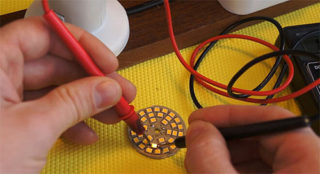
The multimeter is a special tester for electrical products that combines the functions of different devices. On the external panel there is a switch and several positions, one of them is for testing the LEDs. Procedure:
- Switch on the device, set the required mode.
- Use special probes to touch the "legs" of the LED (outgoing wires).
- If the number 1 appears on the screen, change the polarity, repeat touching with the probes.
- If a sound appears and the diode starts to glow, everything is fine, if not, the LED is inoperative.
When it is known that the LED lamp is working properly, but the multimeter shows something else, you need to check the correct assembly of the circuit: the position of the tester, the connection of the contacts. If in this case the multimeter shows a malfunction, the resistor is out of order.
LED color coding
A simpler letter designation is taken for the generally accepted (unofficial). They are mainly used for LED strips. In addition to the general characteristics, they indicate the degree of protection of the element against the penetration of debris and moisture - IP and numbers from 0 to 6.
To choose a good option for replacing outdated light bulbs, you need to find out what kind of LEDs are, and set the parameters of the connected electrical network: voltage, current, resistance.
It is impossible to focus on cost - brands of cheap LEDs often have overestimated parameters, use unstable materials.

